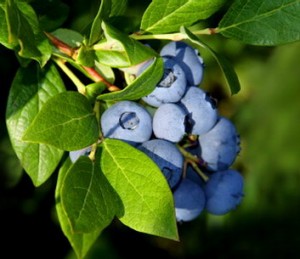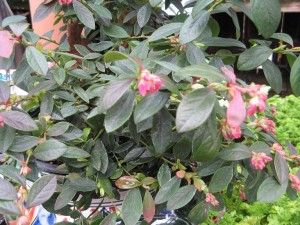It’s berry time, and we’ve got a nice crop of plants that will be so LOADED with berries next spring that you will barely see the leaves! They will give a harvest that first season and fruit will be produced for months, so they’re gonna give you you’re money’s worth right away.
Why we love blueberries-
Blueberries are an excellent and permanent addition to edible and ornamental landscapes because, thanks to modern breeding, they are very easy to grow. The handsome plants have dark blue-green foliage and attractive pink or white ‘ bell’ blooms in spring, which turn into yummy blue summer berries.
Some even have great autumn color, with a full spectrum of yellow, orange and red. All can be planted in the veggie garden or used in the landscape. All this and the bonus of luscious fruit loaded with anti-oxidants! Since they are a permanent addition to the garden, the yields of berries increase each year.
Planting
In our fabulous gardening climate, blueberries can be planted most anywhere from full sun to part sun. Just be sure the location gets at least a half a day of good sunlight. Since they are long lived, it is a wise idea to amend the soil properly when planting. A wide, fairly shallow planting hole, backfilled with half Master Nursery Planting Mix and half our native soil along with a dollop of Master Start fertilizer would be great. After planting, mulch with a bit of additional Planting Mix to help with moisture retention. Planting distance can be up to 5 feet apart or as close as 3 feet for a hedge effect. Or, intersperse them throughout the garden. Blueberries easily adapt to containers and to make it even easier, you can use Master Nursery Planting Mix straight from the bag. You could even add flowers and herbs to the container for a beautiful effect.
Care
It’s so easy! The new blueberries are low maintenance, vigorous plants. They like routine water like your other garden plants and monthly feeding  March through October with our Camellia Azalea food or our veggie food. Your berries will produce more and bigger fruit with a bit of winter pruning. First remove any dead wood, then thin out about a third of what remains. As the plant grows older, you can select six or so main erect branches to form its permanent structure.
March through October with our Camellia Azalea food or our veggie food. Your berries will produce more and bigger fruit with a bit of winter pruning. First remove any dead wood, then thin out about a third of what remains. As the plant grows older, you can select six or so main erect branches to form its permanent structure.
Selection
We select and prefer the southern highbush varieties as they are particularly suitable for our Sonoma County climate. They love the warm days as well as the cool ones and thrive in our mild winters. Three plants are about the minimum for a family but there are, of course, no limits. Blueberries are self pollinating. So, if you remember 7th grade science, that means you only need one plant to get some fruit. However, the more the merrier in the world of the birds and bees. In fact, the fruit will be much more prolific if you plant two or more varieties. Also, by mixing varieties you can easily extend your harvest. Some of our favorites (but we love them all)…
Jubilee: Fruits early, nice and upright
Misty: Fruits very early with lots of berries
O’Neal: Another very early variety
Sharpblue: Fruits early to mid season and great to extend the season. Fast grower with big berries.
Star: Fruits early with large berries
Sunshine Blue: Mid season, a more compact plant and evergreen.
Plus others, of course, and please feel free to ask us any questions about blueberries or other parts of your garden. At least in the garden, we want you happy, healthy and successful.

